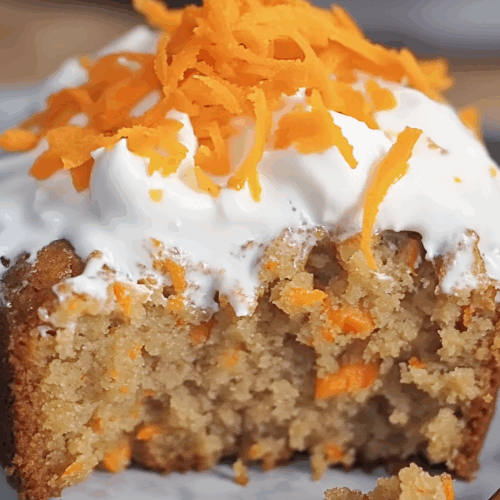The American Revolution was a time of great upheaval, not only in terms of politics and warfare but also in the daily lives of the colonists. Food shortages, trade blockades, and rationing meant that people had to get creative in the kitchen.
One of the clever culinary creations that emerged during this period was the carrot tea cake. This simple yet delicious dessert used readily available ingredients in a time of scarcity. In this post, we explore the origins of carrot tea cake, its connection to the American Revolution, and how you can recreate this historic treat in your own kitchen.
The Carrot Tea Cake at Fraunces Tavern
On November 25, 1783, a pivotal moment in American history unfolded in the heart of New York City. The long and grueling American Revolution had finally come to an end, and the last of the British troops were evacuating New York, marking the return of the city to American control.
To celebrate this momentous occasion, a grand banquet was held at the Queen’s Head Tavern, soon to be renamed Fraunces Tavern, one of the most historic and beloved gathering spots in the city.
Among the distinguished guests were the future first president of the United States, George Washington, French Ambassador Luzerne, and a hundred of the most important generals, officers, and civilians who had played crucial roles in the fight for independence.
Fraunces Tavern, owned by Samuel Fraunces, was not just a popular meeting place but also a symbol of the American spirit. Samuel Fraunces, known as “Black Sam,” was a free man of African descent and a staunch patriot who had used his tavern to host meetings of the Sons of Liberty and other revolutionary figures throughout the war.
His establishment had served as a hub for planning and communication during the struggle for independence, making it the perfect setting for this celebratory feast.
As the guests gathered to celebrate the British evacuation and the successful conclusion of the Revolutionary War, the banquet featured an array of dishes that reflected both the frugality and the ingenuity of the American people during the war years.
Roasted lamb, sorrel soup, and a tipsy squire (a traditional dessert) were among the items on the menu, but one dish that stood out for its simplicity and historical significance was the carrot tea cake.
Carrot Tea Cake: A Revolutionary Dessert
Carrot tea cake had become a popular dessert during the war due to the scarcity of sugar and other imported ingredients. Carrots, with their natural sweetness, were often used as a substitute for sugar in baking. This practice not only allowed colonists to enjoy sweet treats during a time of rationing but also demonstrated their resourcefulness and adaptability in the face of hardship.
The inclusion of carrot tea cake at the Fraunces Tavern banquet was symbolic of the colonists’ ability to make do with what they had, even in the most trying times. The cake’s presence at such a significant event also highlighted the connection between food and the American Revolution.
This connection extended beyond mere sustenance to embody the very spirit of the struggle for independence.
Fraunces Tavern itself is steeped in history. It was the site where George Washington bid an emotional farewell to his officers just a few days later, on December 4, 1783. The tavern remains a symbol of the American Revolution, and its role in hosting this grand celebration solidified its place in American lore.
The tradition of carrot-based desserts continued long after the revolution, with carrot cakes and puddings becoming staple desserts in American households. Today, carrot tea cake serves as a delicious reminder of the resourcefulness of the American people during the revolution and the enduring legacy of the fight for independence.
The Dish Explained: Carrot Tea Cake
Carrot tea cake is a simple, rustic dessert that highlights the natural sweetness of carrots. The grated carrots not only add flavor but also keep the cake moist, while warm spices like cinnamon and nutmeg provide depth and warmth. This cake is perfect for serving with tea or coffee, and it can be dressed up with a light glaze or a dusting of powdered sugar for a touch of elegance.
If you’re enjoying my work, consider checking out Eats History Shop for my e-cookbooks!

Carrot Tea Cake
Ingredients
- 1 1/2 cups all-purpose flour
- 1 teaspoon baking powder
- 1/2 teaspoon baking soda
- 1/2 teaspoon ground cinnamon
- 1/4 teaspoon ground nutmeg
- 1/4 teaspoon salt
- 1/2 cup unsalted butter softened
- 3/4 cup honey or maple syrup as a natural sweetener
- 2 large eggs
- 1 teaspoon vanilla extract
- 1 1/2 cups grated carrots about 3 medium carrots
- 1/4 cup milk
Instructions
Preheat the Oven:
- Preheat your oven to 350°F (175°C).
- Grease and flour an 8-inch round or square cake pan.
Prepare the Dry Ingredients:
- In a medium bowl, whisk together the flour, baking powder, baking soda, cinnamon, nutmeg, and salt. Set aside.
Mix the Wet Ingredients:
- In a large mixing bowl, cream the softened butter and honey (or maple syrup) until light and fluffy.
- Beat in the eggs, one at a time, followed by the vanilla extract.
Combine the Ingredients:
- Gradually add the dry ingredients to the wet mixture, alternating with the milk, beginning and ending with the dry ingredients. Mix until just combined.
- Fold in the grated carrots, ensuring they are evenly distributed throughout the batter.
Bake the Cake:
- Pour the batter into the prepared cake pan and spread it evenly.
- Beat in the eggs, one at a time, followed by the vanilla extract.
- Allow the cake to cool in the pan for 10 minutes before transferring it to a wire rack to cool completely.
Serve:
- Once the cake has cooled, you can serve it as is, or top it with a light glaze made from powdered sugar and milk.
- Slice and enjoy with a cup of tea or coffee.